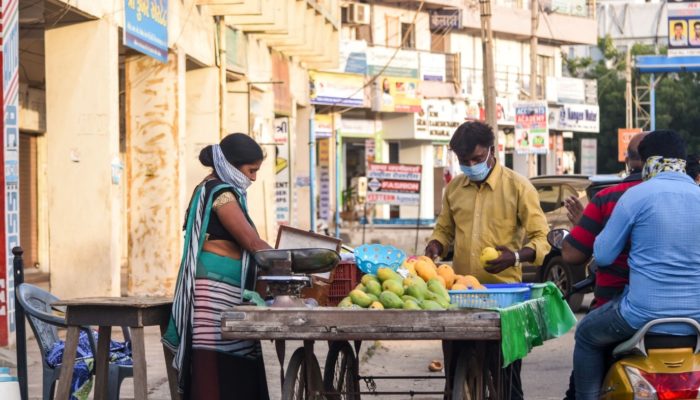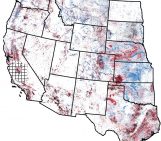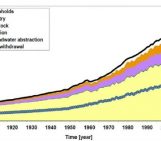
By Carole Dalin
The coronavirus outbreak is a global shock that has affected labour supply, productivity and aggregate demand around the world. However, less is known about what impact this shock will have on global water resources.
Disruptions of global food systems caused by the Covid-19 pandemic are, at least for now, more linked with the supply chain than with food production or food stocks. Indeed, early on in the crisis, the United Nations’ Food and Agriculture Organization (FAO) and other international agriculture organizations reminded us that current staple food reserves remain high.
Yet, the International Food Policy Research Institute (IFPRI), among others, has identified the risk of a spike in global food prices if countries opt to close their borders to trade of agri-food products. Such protectionist measures could be driven by the decline in air and ship cargo activities and by fear of SARS-CoV-2 contamination of food products. You can see how food prices have fluctuated since the onset of the Covid-19 pandemic using IFPRI’s Food Security Portal here. While Covid-19-related price increases have been linked to food insecurity, the water resource consequences remain unaddressed.

Figure 1: A screenshot of IFPRI’s Food Price Monitor – tracking market conditions for foods in India, Kenya, and Rwanda.
A second, major disrupting factor to global food systems is the reduced ability to work for billions of people due to lockdown measures implemented to slow the pandemic’s spread. This drastic reduction in activity and movement of people (lockdowns have been implemented on all continents) affects agricultural production because key workers, including trans-boundary workers, are not able to carry out harvests. As agriculture is, by far, the dominant water-consuming sector, disruption to agricultural production will certainly impact water resources. For instance, the decline in agricultural workforce could affect irrigation use as fewer people and fewer financial resources are available to develop, operate, maintain or repair irrigation systems. However, this discussion remains speculative in the absence of studies on the evolving matter.
The discussed food system disruptions affect food growers, both large and small, and suppliers alike. The FAO assessed that “transport restrictions and quarantine measures are likely to impede farmers’ and fishers’ access to markets, curbing their productive capacities and hindering them from selling their [products]”, while highlighting that “aquatic products, which are highly perishable and therefore need to be sold, processed or stored in a relatively limited time are at particular risk.” Indeed, the contents of our plates are changing. Driven by supply disruptions, the fear of food shortages and sometimes lower-income consumers have bought less perishable (fresh) food, such as vegetables, fruits, and animal-sourced foods since the pandemic started.
Depending on how long the pandemic lasts, the consequences for agricultural production and water use could prove to be significant. If these food demand changes persist, the production of vegetables, fruits and animal-sourced foods could decline, which (while having negative dietary implications) could reduce water demand and consumption as these products are more water-intensive than staple crops (e.g. see Dalin et al. 2017).
| Box 1: Food loss means water loss
Besides the risk of trade restrictions which lead to increased food prices, significant food losses have been another consequence of the pandemic. Large amounts of specialized food (e.g. milk for coffee shops, potatoes for fries) and fresh produce sold in temporarily shut informal markets were lost due to the difficulty of quickly reorganizing food flows within the supply chain. Importantly, food products consume water in their production (this is called virtual or embedded water), and their loss effectively wastes this water used for their making. |
Similarly to how lockdown-induced reductions in automobile traffic has decreased air pollution levels (link, link), it is possible that Covid-19 disruptions to the food system may lead to reduced irrigation use and its associated groundwater depletion. This irrigation decline might occur due to the general slowing of food production activities, but also due to shifts in demand. As mentioned above, the declining demand in fruits and vegetables, which are generally more groundwater-intensive than grains may reduce groundwater consumption and depletion as demands shift to less water-intensive staple crops like cereals. However, other staples such as rice or sugarcane are also water-intensive and their increased demand may have a counter-balancing effect on water demand.
One cannot predict, for now, what the overall impact the coronavirus pandemic will have on water resources through its food system disruptions. Largely, the outcome will depend on the duration of the pandemic and its legacy effects on food demand. In countries where lockdown measures have been lifted or eased, food demands have largely returned to pre-pandemic levels. As worldwide coronavirus cases increase beyond 11 million and with daily new cases not far from all-time highs, we are certainly far from realizing the full extent of Covid-19. Will a potential second-wave of infections impact food systems like the first wave did? Will some countries push for increased domestic production to avoid relying on imports, intensifying their water use in the process? Will any of these implications have long-lasting water resource impacts, or will all responses be short-lived? As the saying goes, only time will tell.




